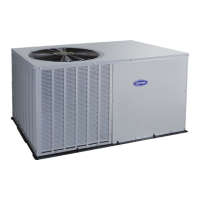
Do you have a question about the Carrier 024-048 and is the answer not in the manual?
| Brand | Carrier |
|---|---|
| Model | 024-048 |
| Category | Air Conditioner |
| Language | English |
Details installation specifications for the residential new construction market.
Covers installation requirements for the add-on replacement/retrofit market.
Provides descriptions for various field-installed accessories for air conditioners and heat pumps.
Specifies minimum operating temperatures for cooling mode with accessories installed.
Describes the standard cabinet construction and panel removal for maintenance.
Details requirements for replacement gaskets and insulation materials for cabinet panels.
Warning about electrical hazards and safety precautions for trained personnel.
Guidelines for using aluminum wire in branch circuits, including NEC compliance.
Explanation of contactor function, troubleshooting steps, and checking continuity.
Details on capacitor function, testing procedures, and safety warnings.
Explains the demand defrost control features, initial intervals, and automatic adjustment.
Describes the operation of the defrost control in cooling mode.
Explains how the defrost control operates when the unit is in heating mode.
Details the defrost mode operation, timing, and termination conditions.
Procedures to test the defrost function by forcing a defrost cycle using speed-up pins.
Explains the process of gas compression within a scroll compressor.
Discusses compressor failures related to mechanical issues, excluding electrical circuits.
Describes compressor failure due to motor drawing locked rotor current and cycling off internal protection.
Explains compressor failure where motor runs but does not pump refrigerant, causing overheating.
Covers common causes of compressor noise, including internal and external factors.
Details compressor failures where the motor does not run despite normal external systems.
Provides steps to identify compressor motor terminals (C, S, R) using an ohmmeter.
Procedure to test for breaks in motor winding internal wires, indicating an open circuit.
Method to check if a wire has broken or contacted the shell, causing a short to ground.
Explains compressor failure where hot discharge gas returns to shell, causing overheating.
Describes capacity loss due to damaged internal compressor parts like valves.
Discusses detecting and repairing leaks at compressor shell welds or fittings.
Procedure to test for wires breaking insulation and shorting windings due to internal wire contact.
Details the function, enclosed nature, and replacement procedures for the outdoor fan motor.
Discusses R-410A refrigerant properties, pressure, and system requirements for handling.
Details the hygroscopic nature of POE/PVE oil used in R-410A systems and precautions.
Provides basic points and rules for brazing techniques in refrigeration systems.
Explains the reversing valve function, troubleshooting, and replacement procedures.
Describes the function of liquid line filter driers specifically designed for R-410A refrigerant.
Details the use and installation of suction line filter driers for acid removal in R-410A systems.
Explains the accumulator's role in storing liquid refrigerant and preventing flood-back in heat pump heating mode.
Describes how the TXV adjusts refrigerant flow to maintain preset superheat temperature.
Explains the protection provided by strainers and filter driers for TXVs.
Details the procedure for cleaning or replacing a piston in the flow control device.
Describes using a vacuum pump and gauge to achieve a deep vacuum for system evacuation.
Details the procedure for evacuating a system using nitrogen to remove moisture.
Steps to verify indoor airflow and check subcooling before troubleshooting superheat.
Addresses low superheat conditions with normal or low suction pressure in TXV systems.
Addresses low superheat conditions with high suction pressure, typically caused by component failure.
Discusses high superheat conditions with normal or low suction pressure, indicating restrictions.
Covers high superheat with normal or high suction pressure, often due to application issues.
Describes hunting superheat, an issue with TXV systems typically related to application or valve imbalance.
Procedure for evacuating the system and weighing in the specified amount of refrigerant.
Steps for checking refrigerant charge in cooling mode using superheat for fixed metering devices.
Procedure for checking refrigerant charge using subcooling for TXV metering devices.
